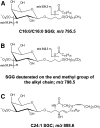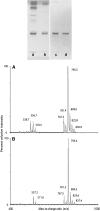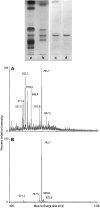Quantification of seminolipid by LC-ESI-MS/MS-multiple reaction monitoring: compensatory levels in Cgt(+/⁻) mice
- PMID: 20817833
- PMCID: PMC2975728
- DOI: 10.1194/jlr.D010116
Quantification of seminolipid by LC-ESI-MS/MS-multiple reaction monitoring: compensatory levels in Cgt(+/⁻) mice
Abstract
Seminolipid, also known as sulfogalactosylglycerolipid (SGG), plays important roles in male reproduction. Therefore, an accurate and sensitive method for SGG quantification in testes and sperm is needed. Here we compare SGG quantitation by the traditional colorimetric Azure A assay with LC-ESI-MS/MS using multiple reaction monitoring (MRM). Inclusion of deuterated SGG as the internal standard endowed accuracy to the MRM method. The results showed reasonable agreement between the two procedures for purified samples, but for crude lipid extracts, the colorimetric assay significantly overestimated the SGG content. Using ESI-MS/MS MRM, C16:0-alkyl/C16:0-acyl SGG of Cgt(+/⁻) mice was quantified to be 406.06 ± 23.63 μg/g testis and 0.13 ± 0.02 μg/million sperm, corresponding to 78% and 87% of the wild-type values, respectively. CGT (ceramide galactosyltransferase) is a critical enzyme in the SGG biosynthesis pathway. Cgt⁻/⁻ males depleted of SGG are infertile due to spermatogenesis arrest. However, Cgt(+/⁻) males sire offspring. The higher than 50% expression level of SGG in Cgt(+/⁻) animals, compared with the wild-type expression, might be partly due to compensatory translation of the active CGT enzyme. The results also indicated that 78% of SGG levels in Cgt(+/⁻) mice were sufficient for normal spermatogenesis.
Figures





Similar articles
-
Properties, metabolism and roles of sulfogalactosylglycerolipid in male reproduction.Prog Lipid Res. 2018 Oct;72:18-41. doi: 10.1016/j.plipres.2018.08.002. Epub 2018 Aug 25. Prog Lipid Res. 2018. PMID: 30149090 Free PMC article. Review.
-
The specific localization of seminolipid molecular species on mouse testis during testicular maturation revealed by imaging mass spectrometry.Glycobiology. 2009 Sep;19(9):950-7. doi: 10.1093/glycob/cwp089. Epub 2009 Jun 19. Glycobiology. 2009. PMID: 19542524
-
Arylsulfatase A deficiency causes seminolipid accumulation and a lysosomal storage disorder in Sertoli cells.J Lipid Res. 2011 Dec;52(12):2187-2197. doi: 10.1194/jlr.M019661. Epub 2011 Oct 2. J Lipid Res. 2011. PMID: 21965315 Free PMC article.
-
Quantification of short chain amines in aqueous matrices using liquid chromatography electrospray ionization tandem mass spectrometry.J Chromatogr A. 2017 Jan 13;1480:106-111. doi: 10.1016/j.chroma.2016.12.037. Epub 2016 Dec 15. J Chromatogr A. 2017. PMID: 27993393
-
[Sulfogalactosylglycerolipid in spermatogenesis and fertilization].Zhonghua Nan Ke Xue. 2015 Feb;21(2):175-8. Zhonghua Nan Ke Xue. 2015. PMID: 25796695 Review. Chinese.
Cited by
-
Properties, metabolism and roles of sulfogalactosylglycerolipid in male reproduction.Prog Lipid Res. 2018 Oct;72:18-41. doi: 10.1016/j.plipres.2018.08.002. Epub 2018 Aug 25. Prog Lipid Res. 2018. PMID: 30149090 Free PMC article. Review.
-
Fatty acyl-CoA reductase FAR1 is essential for the testicular seminolipid synthesis required for spermatogenesis and male fertility.J Biol Chem. 2025 Jun;301(6):108538. doi: 10.1016/j.jbc.2025.108538. Epub 2025 Apr 25. J Biol Chem. 2025. PMID: 40288649 Free PMC article.
-
Impact of glycosylation on the unimpaired functions of the sperm.Clin Exp Reprod Med. 2015 Sep;42(3):77-85. doi: 10.5653/cerm.2015.42.3.77. Epub 2015 Sep 30. Clin Exp Reprod Med. 2015. PMID: 26473106 Free PMC article. Review.
-
Lipidomic profiling of sinus mucosa from patients with chronic rhinosinusitis.Clin Transl Sci. 2015 Apr;8(2):107-15. doi: 10.1111/cts.12256. Epub 2015 Jan 15. Clin Transl Sci. 2015. PMID: 25588779 Free PMC article.
-
Accumulation of Seminolipid in Sertoli Cells Is Associated with Increased Levels of Reactive Oxygen Species and Male Subfertility: Studies in Aging Arsa Null Male Mice.Antioxidants (Basel). 2021 Jun 4;10(6):912. doi: 10.3390/antiox10060912. Antioxidants (Basel). 2021. PMID: 34199863 Free PMC article.
References
-
- Tanphaichitr N., Bou Khalil M., Weerachatyanukul W., Kates M., Xu H., Carmona E., Attar M., Carrier D. 2003. Physiological and biophysical properties of male germ cell sulfogalactosylglycerolipid. Lipid Metabolism and Male Fertility. De Vriese S. R., Christophe A. B., AOCS Press, Champaign, IL: 125–148.
-
- Ishizuka I. 1997. Chemistry and functional distribution of sulfoglycolipids. Prog. Lipid Res. 36: 245–319. - PubMed
-
- Attar M., Kates M., Bou Khalil M., Carrier D., Wong P. T. T., Tanphaichitr N. 2000. A Fourier-transform infrared study of the interaction between germ-cell specific sulfogalactosylglycerolipid and dimyristoylglycerophosphocholine. Chem. Phys. Lipids. 106: 101–114. - PubMed
-
- Goto-Inoue N., Hayasaka T., Zaima N., Setou M. 2009. The specific localization of seminolipid molecular species on mouse testis during testicular maturation revealed by imaging mass spectrometry. Glycobiology. 19: 950–957. - PubMed
-
- White D., Weerachatyanukul W., Gadella B., Kamolvarin N., Attar M., Tanphaichitr N. 2000. Role of sperm sulfogalactosylglycerolipid in mouse sperm-zona pellucida binding. Biol. Reprod. 63: 147–155. - PubMed
Publication types
MeSH terms
Substances
LinkOut - more resources
Full Text Sources
Molecular Biology Databases

